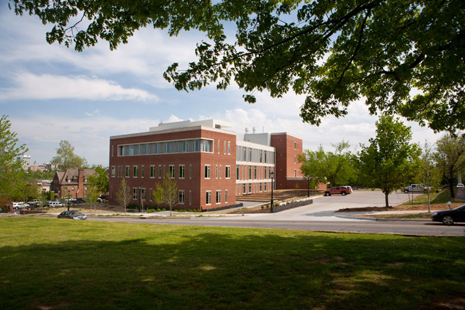
FAYETTEVILLE, Ark. – University of Arkansas faculty, staff, students and friends joined Gov. Mike Beebe and Scott Livingston of Livingston Securities LLC to dedicate the Nanoscale Material Science and Engineering Building on the University of Arkansas campus at 1 p.m. Friday, Sept. 16.
Investment in nanotechnology research at the university began 16 years ago, and during those years, the number of nanotechnology researchers has expanded to 25 tenure-track faculty members in fields including physics, engineering, chemistry and biology. The new building on Dickson Street puts much of that interdisciplinary research under one roof.
“The field of nanoscience is producing new discoveries and developments virtually every day,” said Chancellor G. David Gearhart. “Thanks to outstanding faculty and student research, we are proud to be the hub of much of that activity. I am thankful to Governor Beebe for his commitment to the work going on inside this building and across campus.
“Furthermore, I am excited about the future of nanotechnology research and applications here in our state,” Gearhart continued. “The work taking place through or in conjunction with the Institute for Nanoscience and Engineering reiterates our university’s role as an educational and economic partner, resource and catalyst serving Arkansas and beyond. This state-of-the-art facility and the interdisciplinary approaches taking place in the classrooms and labs strengthen the University of Arkansas’ position as a leader in nanoscale science and engineering.”
Because of the atomic-level research that takes place in the building, its rooms were built with the needed specifications to support nanoscale research. Rooms with sensitive instruments have vibration isolation to prevent interference. Other rooms have electromagnetic wave isolation, so that even seemingly innocent devices such as cell phones cannot penetrate the space. Still other rooms have ultrasensitive temperature control. The building also houses a class 100 cleanroom, a room where the air is so efficiently filtered that fewer than 100 particles of dust a millionth of a meter in diameter or larger can be found in any cubic foot of air over a minute’s time.
The building also houses an innovative approach to graduate education, consisting of three different rooms. The discovery room, surrounded by writable walls, brings students together from different disciplines to throw ideas into the community for the vigorous types of discussions that assure both rapid concept evolution and survival of only the fittest ideas. This atmosphere is aided by computation and design tools focused at the nanoscale, with communication enhancements such as electronic whiteboards, teleconferencing capabilities and wireless connectivity to large-screen computer displays.
Once students have a well-developed idea, a small team transfers the idea to the launch room. This area is designed for detailed strategic discussions as the students map out a combined technology and business plan to fabricate a new nanoscale material or structure that meets the needs of a particular Arkansas industry or small business. The rooms create an innovative workspace that function more like the research and development division of a company rather than a classroom.
Researchers housed in the new building study many aspects of nanotechnology, including creating biosensing devices; developing nanoparticle-based disease diagnostics and therapies; using nanoscale scaffolding for stem-cell growth, drug release, neuron regeneration, bone implants and stents; examining the impact of defects on properties of nanoscale materials; enhancing properties of nanoscale materials; and creating high-quality novel nanoscale materials.
Topics
Contacts
Melissa Blouin, senior director of academic communications
University Relations
479-575-3033, blouin@uark.edu
Danielle Strickland, director of development communications
University Relations
479-575-7346,
strick@uark.edu